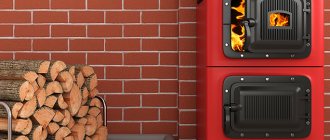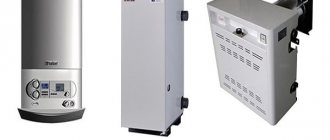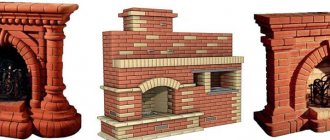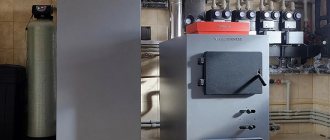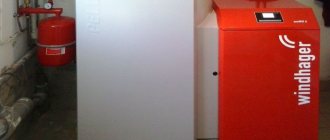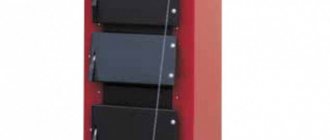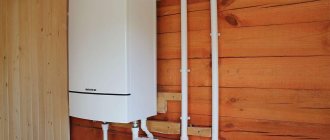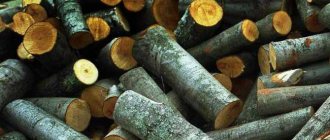Combined gas-wood boilers are, first of all, solid fuel boilers that have only a slightly modified design into which you can install a gas burner that burns natural or liquefied gas. Replacing the burner is done quite quickly, on your own, according to the manufacturer’s instructions, so combination boilers are multifunctional and, despite different opinions, retain the reliability and durability of simple solid fuel and gas models.
Despite all the advantages, we do not recommend considering combined models (with the exception of a few cases), since purchasing a separate gas boiler and a solid fuel boiler will cost much less, and the disadvantages of a dual-fuel design are often significant. Let's look at everything in order.
What are gas-wood combination boilers?
Mixed-type boilers operating on solid fuel and gas are always a floor-standing design, the dimensions corresponding to conventional solid fuel models. Without the use of a gas burner, these are ordinary solid fuel boilers that burn not only wood, but also coal, pellets, peat, and anthracite. Piping, installation and connection of universal boilers is carried out similarly to single-fuel boilers.
Why are they needed and how are they used?
As we have already said, without special conditions, the purchase of a gas-solid fuel boiler is not justified either economically or practically.
Firstly , the total cost of separately purchased gas and solid fuel boilers is 90% lower than the combined model. The cost of gas-wood boilers is 19,000-35,000 rubles and the gas burner is not included in this amount: it must be purchased separately. Only in rare cases are ready-made assemblies found with a gas burner included. The cost of the burner is on average another 6-12 thousand rubles.
The most economical of the budget simple boilers for heating a private home
Secondly , the efficiency and functionality of individual single-fuel models is almost always higher than combined ones. The usual design of a solid fuel boiler does not show the highest efficiency (at best, up to 85%) when burning natural or liquefied (cylinder) gas, when even budget gas boilers have an efficiency of 88-92%. And this, accordingly, is lower consumption with the same heat transfer. Also, combined gas-wood boilers are devoid of any functional automation, which is found even on budget gas models.
Thirdly , a small bonus of two single-fuel boilers is that if one breaks down, the second can be used as a backup.
However, there are cases when buying a universal boiler that runs on gas and wood may be more profitable. For example:
- if you have access to any type of solid fuel for a symbolic price. When solid fuel reserves are exhausted, stable combustion without human intervention is required, or a previously missing gas line is installed near the house, you can always switch to a gas burner;
- if the area of the house is quite small and allocate at least 8 square meters. m. area for separate single-fuel boilers is impossible.
Design and principle of operation
Combined model with an installed gas burner.
Diagram using the Teplodar Kupper OK 15 model as an example. The design of such boilers is traditional: solid fuel is burned in the combustion chamber, the walls of the chamber are a heat exchanger, inside of which the coolant circulates through the system. Fuel is loaded through the door at the front, and ash is collected in the ash drawer below.
If you need to switch to gas, a gas burner with the appropriate fastening (without welding) is installed on the ash pan door or a specially designated mount. However, the design of the heat exchanger, designed for a large combustion chamber volume, accumulates much less thermal energy when burning gas; the efficiency remains only within 75-85%, as when burning high-quality solid fuel.
There are also high-tech hybrid models on the market with 2 fireboxes, in which fuel can be burned simultaneously. Solid fuel is usually burned in the upper combustion chamber, a gas burner is installed in the lower one, and a compact ash box and heat exchanger design separate the combustion chambers. However, the cost of such models is in the range of 200-350 thousand rubles.
Two-furnace model.
Boilers with a burning duration of one load of fuel up to 7 days
Are there any special features in operation?
When purchasing a combined boiler with wood and gas heating, you need to take into account several operational points, without which the use of firewood as the main source of heat can lead to the fact that the universal method will cause considerable problems.
So, during its operation, a wood-burning boiler gradually clogs the chimney with soot, which must be periodically cleaned. Without this, the efficiency of smoke removal will gradually decrease, until problems with ignition, smoke in the room, etc. appear.
Rice. 4 Chimneys require regular cleaning
If gas or electric heating can operate continuously, then a wood-burning boiler burns out completely after a maximum of 3-4 hours, after which the heating system inevitably begins to cool down. Loading a new portion is done manually, which requires the owner's home. Therefore, combined modifications with wood or pellet fuel are often used, if possible, in gas heating mode.
Pellets partially allow you to automate the heating procedure with wood fuel, but you still have to monitor the process. And the reserve must be created in advance, otherwise you may be left without heating during the coldest period of the year.
Reviews of universal solid fuel and gas boilers: advantages and disadvantages
| Advantages | Flaws |
| Significant space savings, which is especially important for small houses with an area of 40-80 m2. The dimensions of combined models do not differ from single-fuel models | Primitive automation or its complete absence (mechanical traction control) |
| Availability of single-circuit and double-circuit models | In more than 95% of cases, a gas burner is not sold complete with the boiler |
| Almost all models are non-volatile (do not require connection to the mains) | Owners often note the rather high noise level of the burners, which is not comparable to the standard burners of gas boilers. |
| In combined models, durable cast iron heat exchangers are often used, while budget solid fuel and gas heat exchangers almost always use steel ones that are vulnerable to corrosion. | Higher requirements for chimney draft, which complicates calculations. If the design is incorrect, the thrust may not be sufficient for complete combustion of gas. |
| Small selection of multi-fuel combined models, especially foreign ones |
Equipment installation
Installation of a gas boiler is carried out in frost-free rooms . The installation location must be agreed upon with specialized services.
Before choosing a location for installation, it is necessary to plan how combustion products will be removed. This is usually done by installing separate pipes , or using existing chimneys. The chimney system is often included.
First, the floor is prepared. Since the boiler is heavy, the base underneath must be strong. If necessary, the screed is poured. The floor under the boiler must have a fireproof coating . In its absence, hollow concrete blocks are placed on the floor and covered with a sheet of metal on top. The height of the blocks is 100 mm, the thickness of the metal is 0.8 mm. It is also possible to use fireproof boards.
If the surface is covered with non-flammable materials, then there should be
at least 10 cm from the device to the wall. To place the device close to each other, the wall must be finished with fire-resistant materials. The base of the wall is insulated with roofing steel laid on asbestos with a thickness of 30 cm. The dimensions of the device body around the perimeter are at least 10 cm. All protruding parts of the boiler, parts of the fittings are removed from the walls by at least 1 m.
The boiler must be installed as level as possible. Checking is carried out using a building level. If necessary, place a solid non-combustible material under the legs of the device. The equipment is connected to the in-house heating system and to the chimney. A double-circuit boiler is connected to a cold water pipeline.
It is advisable to install the boiler so that it is easy to dismantle . Shut-off valves are installed on all pipes of the device. They are needed to dismantle equipment without discharging water from the existing system.
Work on installing the boiler can be carried out independently, however, for safety reasons, it is better to carry out the first start-up of the equipment with a specialist.
How to choose a combi boiler
The selection criteria are almost the same as when choosing a TT model. You definitely need to decide on:
- Number of contours . Single-circuit models are more common; they heat only the heating circuit. Double-circuit models are also capable of heating sanitary water (it does not mix with process water from the heating circuit). Double-circuit models are 10-40% more expensive, but this is still the cheapest way to organize hot water supply in a house.
- Burnt fuel . Basically, combined boilers are designed to burn both coal and charcoal, firewood, pellets, and peat. Models with a cast iron heat exchanger are capable of burning anthracite. But some boilers are designed only for firewood. Types of fuel are always described in the technical specifications or boiler passport.
- Heat exchanger material . There are two options: steel or cast iron. Steel heat exchangers are inexpensive to produce, lightweight, resistant to temperature changes and mechanical damage, but have thin walls and are not resistant to corrosion; their service life is on average 12-15 years. Cast iron heat exchangers are heavy, have thick walls, are not subject to corrosion and last more than 30 years, but are used in more expensive models.
- Working pressure . Some models are designed for an operating pressure in the system of no higher than 1 bar, which means that they cannot be used in closed heating systems with forced circulation, where the operating pressure is usually 1.5-2 bar.
- Efficiency . It is not the most informative indicator when burning solid fuel, since it strongly depends on its quality (dryness and type of wood, ash content and calorific value of coal). However, when using a gas burner, 4-5% efficiency can pay for the higher cost in one heating season. The optimal efficiency indicator is 80% and above.
Minimum required power
For an average uninsulated or poorly insulated house in the climatic zone of the Moscow region, with 2 bricks and a ceiling height of 2.7 m, the minimum required power is calculated using a simple formula: 1 kW for every 10 m2. We also recommend setting aside a power reserve of 20-30%.
For example, for the average house described above with an area of 100 m2, the minimum required power of heating equipment is 100/10 * 1.3 (30% reserve) = 13 kW. Boilers of this power are not found on the market, so we round up to the nearest higher value - 14 or 15 kW.
Also, when purchasing a double-circuit boiler, it is recommended to add another 10-15% to the result, since when heating hot water, the heating circuit is not heated. Total 13 kW * 1.1 (10% reserve) = 14.3 kW. If the house is located in the extreme southern or northern point of the country, is well insulated, has high ceilings or a large glazing area, correction factors are taken into account, changing the result by 5-30% up or down.
How to accurately calculate the required boiler power Individual calculation, formula and correction factors
Coal-gas
The universal gas-coal boiler is environmentally friendly and easy to maintain. However, when choosing this type of design, you will have to constantly monitor the availability of solid fuel, because coal runs out quickly. If you suddenly come to the conclusion that “two in one” is not suitable for you, then you can always replace the burner - and the boiler will already operate on natural gas.
You can read more about the features of a pellet boiler here.
Most often, a combined coal-gas boiler can also be heated with wood. For example, in the technical characteristics of the dual-circuit model “Beryozka V”, in the “fuel” item it is indicated “natural gas / coal” (see table). However, buyers use such a boiler for heating with wood.
| Manufacturer and model | Characteristic |
| ATEM (Zhytomyr, Ukraine) Berezka V | The boiler is made of steel, is universal and completely independent of electricity. It acts as a budget solution for heating cottages, utility rooms, and outbuildings. Units of brand “B” are created for the production of consumer hot water. Fuel - natural gas / anthracite (coal). The area of the heated room is 125 m². Rated thermal power - 12.5 kW. Maximum gas flow is 1.5 m³/h. Nominal gas pressure (min/max) - Pa 1274+100 (635/1794). Working water pressure is 0.1 MPa. Efficiency when using solid fuel is 78%. Efficiency when using natural gas is 90%. Weight - 119 kg. DHW water consumption - 280 l/h. The combustion chamber is open (chimney). Number of circuits: double circuit. |
The best known manufacturers and models: characteristics and prices
Teplodar Kupper OK 15
The most famous domestic combination boiler, burning coal, wood, pellets, natural gas (when installing a burner). It is distinguished by time-tested reliability at a low cost, successful design of the firebox, and ease of cleaning. Separately, it is worth noting the presence of blocks of heating elements with a power of 6 kW, with the help of which you can heat the coolant for a long time if the solid fuel burns out completely at night. The owners also note a rather nice stylish design and build quality.
However, there are also a sufficient number of disadvantages: a small loading hole and the firebox itself (firewood up to 35 cm), a steel heat exchanger, relatively low efficiency, high soot formation.
Viadrus Hercules U22 D-4
One of the best combined gas-wood boilers for heating a private home, also one of the most popular. The Czech model with a cast iron heat exchanger is characterized by ease of use and well-known durability, ensured by good alloys and build quality. The boiler has a fairly good efficiency of 80%, is absolutely omnivorous, has an optimal firebox size (firewood 40-45 cm long can be placed), and also has compact dimensions and a stylish appearance.
According to reviews from owners, when the draft valve is tightly closed, abundant soot formation is typical. The cast iron structure, depending on the power variation, weighs on average 250 kg, so a reinforced floor is required for installation, and at least 3 people for transportation. Also a relative disadvantage is the price of the Czech model.
Roda Brenner Classic BCR-04
Another practically standard Czech combi boiler with a cast iron heat exchanger and a technologically advanced, efficient and practical design. The body is separated by a layer of thermal insulation, which reduces heat loss through the boiler modules and keeps the body relatively cold. Everything is also distinguished by Czech reliability, practicality during operation and cleaning, and good efficiency.
According to installation experience and reviews from owners, no shortcomings or malfunctions were found over more than 6 years of operation. One can only note that the price is still high for the average Russian buyer.
Cost: 53,000-55,000 rubles.
HEPHAESTUS VPR KSTGV-20
Inexpensive and compact double-circuit combi boiler of domestic production. It has a good efficiency of 80%, achieved thanks to the excellent design of the heat exchanger. The primary heat exchanger is steel, but the secondary (for DHW) is made of copper. Almost always, the factory equipment includes a gas burner of the “BRAY” type with the well-known simple Italian SIT automatic system.
Please note that the maximum permissible operating pressure is only 1 bar. It is also worth noting that the model is quite rare on sale.
Cost: 23,500-26,400 rubles.
Karakan 20 TEGV
Another domestic dual-circuit model. It has the simplest possible design, is not demanding on fuel, has a large loading opening and firebox, as well as a block of heating elements installed from the factory.
However, the heat exchanger is made of steel, the efficiency is only 75%, the weight is 101 kg, and the maximum permissible operating pressure is 1 bar. There have been no service complaints over more than 5 years of operation.
Design and operating principle
The second category of combined heating boilers have a more complex design with two autonomous chambers for different types of fuel. There are 2 options for their location in the boiler body:
- The firebox for firewood is located at the bottom of the body; it contains a grate and an ash chamber with its own door. The natural gas combustion chamber is located above the firebox and is completely insulated. The only channel that connects them is the chimney; it must open for the chamber in operation. The pipe of the second idle furnace is closed with a special damper, controlled automatically or manually.
- Both chambers are located next to each other and have one common wall. They also have a common chimney, and the combustion products make 3 to 5 passes in the smoke pipes, cooling to 150 ⁰C.
Combined wood-gas heating boiler
Some multi-fuel combi boilers are designed to accommodate a pellet or diesel burner, and options include a DHW circuit or even an integrated boiler. An example of such a heating system is ECO-CK Plus from the Austrian brand WIRBEL. This manufacturer declares an efficiency value when working with wood up to 88%. The chamber, which can run on gas or diesel fuel, provides an efficiency of up to 93%. The heating unit is equipped with all the necessary automation depending on the energy carriers used; no additional equipment will have to be purchased.
The operating procedure of two-chamber hybrid installations is as follows: the main type of fuel in them is firewood, which is placed in the appropriate firebox. From ignition to complete combustion of a portion of firewood, approximately 4-5 hours pass, provided that the boiler is operating at full power. When the first firebox begins to die out and the temperature of the coolant begins to drop, the gas burner device of the second chamber automatically comes into operation, maintaining the water temperature at a given level.
Domestic combination boilers for gas and solid fuel cannot automatically switch back to burning wood after the gas burner has turned on. The reason is clear: at home it is impossible to organize automatic supply of wood into the first chamber of a hybrid installation, with the exception of pellets. Therefore, after the firebox has died down, it is necessary to load firewood into it again and turn off the second chamber.
Prices: summary table
| Manufacturer and model | Heat exchanger material | Number of circuits | Efficiency, % | price, rub. |
| Teplodar Kupper OK 15 | steel | single-circuit | 78 | 26 900-36 200 |
| Viadrus Hercules U22 D-4 | cast iron | single-circuit | 80 | 83 000-90 500 |
| Roda Brenner Classic BCR-04 | cast iron | single-circuit | 80 | 53 000-55 000 |
| HEPHAESTUS VPR KSTGV-20 | steel | double-circuit | 80 | 23 500-26 400 |
| Karakan 20 TEGV | steel | double-circuit | 75 | 28 500-31 000 |
Operating the device
To use universal-type boiler equipment, no specialized education is required. Solid fuel is loaded into the firebox through a hatch located in the upper part of the front wall of the product. As combustion proceeds, energy is added. Ash is removed through the bottom door.
If necessary, install a nozzle. Installation is easy. Most nozzles have a universal mount and are suitable for gas boilers of various manufacturers.
If the boiler installation is equipped with a heating element, it is possible to connect to electricity. Before connecting to the power supply, study the technical characteristics of the product. Using an electric water heater allows you to heat a room in the absence of other types of energy sources. The universal wood-gas unit allows you to heat rooms using two types of energy carriers. Some models have a built-in electric water heater and an additional circuit for heating hot water supply.
When choosing a product, a number of factors are taken into account, which allows you to select a model with optimal technical characteristics.
How to select a gas burner for a solid fuel boiler
Model AGG-13K
Universal gas burners for solid fuel boilers, which are not included in the factory components of specific models, are suitable for all boilers, since they have a fairly simple screw fastening. The exception is burners designed for a specific model range. Usually these are burners from the same manufacturer as the boiler. Their name or characteristics indicate, for example, “...for Teplodar boilers.”
Boiler installation and safety precautions
The combined gas boiler is installed in accordance with the operating instructions. To connect to the gas pipeline, you must have permits. Gas/wood heating boilers require a chimney. It is necessary to discharge exhaust gases into the atmosphere.
The dual-fuel unit is heavy. This requires a solid foundation. The floor is made of non-combustible materials. Concrete blocks, refractory bricks or other building materials covered with sheet metal are used as the base. During installation, check that the base is positioned correctly in the horizontal plane. To do this, use a building level.
In terms of installation of the piping, the installation of a universal boiler is no different from the installation of products operating on solid fuel. The heat exchanger is connected to the heating. The hot water supply circuit is connected to the corresponding pipeline. The connected pipelines at the point of connection with the boiler equipment are equipped with shut-off valves. This design allows you to dismantle the product without draining the coolant from the pipeline.


